Behavioral Ecology Exam 4
1/66
Earn XP
Description and Tags
ZOO425 Exam 4
Name | Mastery | Learn | Test | Matching | Spaced |
|---|
No study sessions yet.
67 Terms
mutualism
benefits both parties immediately
kin selection
the evolution of characteristics that favor the survival (and reproduction) of close relatives of the affected individual
direct fitness
genes contributed by an individual via personal reproduction in the bodies of surviving offspring (a relative’s offspring)
indirect fitness
genes contributed by an individual via survival in the bodies of offspring of a related individual (a relative’s offspring)
coefficent of relatedness ®
the pathway that connects focal individuals
alarm calls
who calls - females
who are called to - offspring and other kin
direct reciprocity
prisoner’s dilemma
the prisoner’s dilemma
T>R>P>S
ESS - always defect (to avoid S)
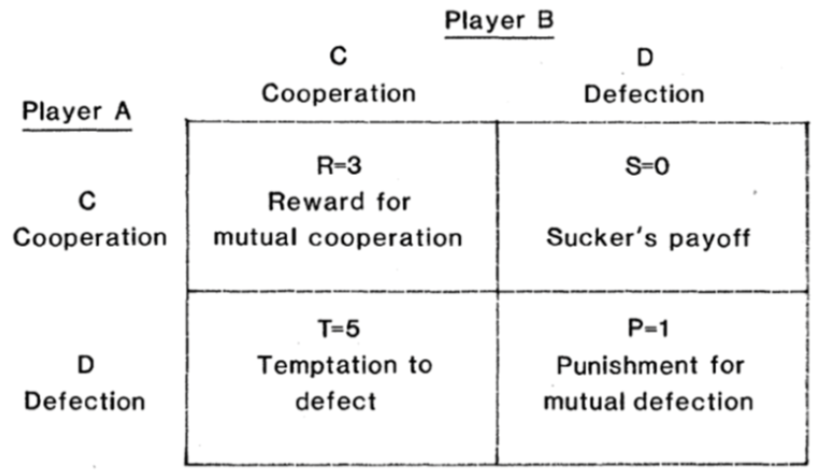
Tit-for-tat strategy
starts with cooperation and then follows whatever move the other player used the next time
retaliation for defections
forgiving because it has a one move memory
tit-for-tat strategy
w = c/b
w
the probability of the two players interacting again
non-linear relationships
ex. vampire bats utility curve

indirect reciprocity (reputation)
reputation based on the last observed interactionsup
upstream indirect reciprocity
A helps B who helps C
downstream indirect reciprocity
indirect reciprocity
q > c/bq
q
the probability of knowing someone’s reputation
requirements for reciprocity
able to recognize individuals
information storage
what someone did
reputation
communication medium
information transfer to learn about reputations
may select for strategic thinking including tactics of deception
artificially changing reputations
may be most effective in certain sized groups
social brain hypothesis
positive correlation between group size and neocortex (the part of the brain associated with social systems and remembering individuals) ratio
E.O. Wilson’s definition of communication
the action on the part of one organism that alters the probability pattern of behavior in another organism in a fashion adaptive to either one or both of the participantsB
Bradbury and Vehrencamp’s definition of communication
the provision of information that can be utilitzed by a reciever to make a decision… an exhange of a signal between a sender and receiver to the benefit of both parties
lack of response
possible reasons:
received the signal?
understand the signal?
ignore the signal?
components of communication

attenuation
reduction in the detectability of a signal (weakened)de
degredation
the quality of the signal is reduced and information content is alterned (changed or corrupted)
functions of communication
recognition (neighbors, kin, intruders)
reproduction (attracting mates, displaying social statuses)
alarm
foraging or food location
types of signals
chemical
auditory
visual
tactile
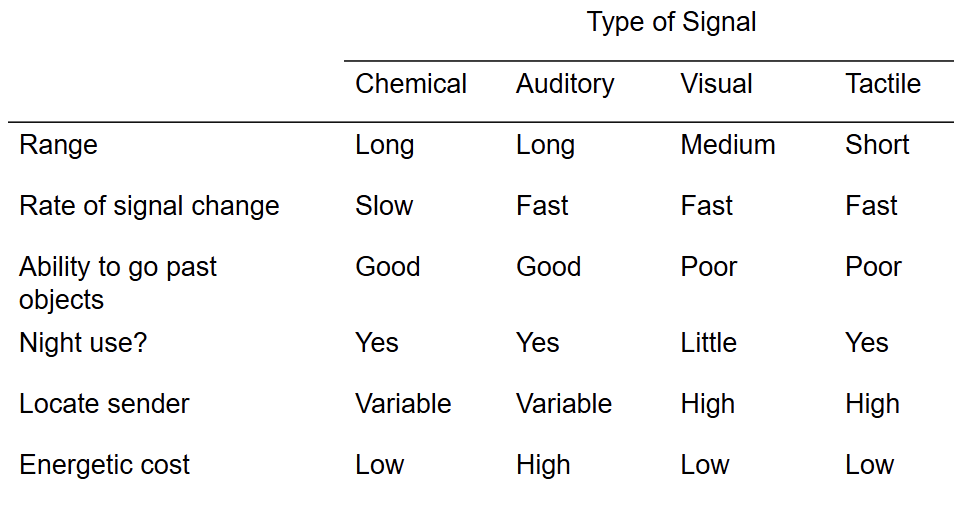
communication example
bee waggle dance
chickadee communication example
differences in alarm calls
whether predators are moving or stationary
wingspan’s negative correlation with the “D” note in a call
illegitimate receivers (“evesdroppers”)
the use of a signal’s information to their own benefits, often to the detriment of the original senders and receivers
ex. aggressive mimicry
ex. predatory firefly flashes to mimic another species mating flashes
ex. predatory assassination bugs and spider web vibration frequency peaks and the spider’s response to the mibrations
plant communication
interspecies and intraspecies signalling with methyl jasmonate (MeJA) and identifying signals (VOCs)
detecting VOCs mean that a plant nearby was attacked and it could be that plant itself (slow nervous system)
suggests it was evolved long time ago
changed behaviors of introduced species
behavioral flexibility
loss of aggression - evolutionary change promoting invasives
ex. fire ants - within their home range they have monogiant colonies (1 queen) and invaded ranges have polygiant colonies (miltiple queens)
ex. increased bird brain sizes makes the birds more adapted to invasions
bullfrog and red-legged frogs
in populations where the species overlap, the red-legged have refuge behaviors to avoid predation
possible conservation for non-overlapping species by introducing overlapping red-legged into the other population to “jump start” evolution/behavior changes
introduced species as evolutionary traps
not recognized as dangerous
creates novel environments
solutions to reduce extinction of invasive-induced evolutionary traps
provide refuge to dampen population declines and allow for time for evolution
move populations of prey species with the invaded species into a population without the invaded species to “jump start” evolution
honeysuckle and buckthorn
possibly change temp, microclimate, food sources, refuge
effect on human health
mosquito oviposition - decreased mosquitoes with increased invasions (even in grassy habitats)
tick-borne diseases (lone star tick) - increased invasion increases deer populations which increases ticks
found in both observation and experiment
seasonal behavior chagnes
increased floor cover (refuge) - increases mice populations
chipmunk torpor
landscape
the mosaic of habitat patches in which a particular habitat patch (the focal patch) is embedded
differs between organisms and depends on the scale
scaling up
individuals —> populations —> communities —> ecosystems/landscapes/biospheres
landscape ecology
understanding how spatial distributions of habitats in landscapes effect ecological processes
functional connectivity
the degree a landscape facilitates and impedes organism’s movements among patches
area sensitivity
the size of the patch affects the patch occupancy
smaller patches hold smaller populations and larger patches hold larger populations
perceptual range
the amount of the environment the individual knows or can determine
determining perceptual range
releasing an individual a certain distance from a preferred habitat and observing where the individual goes
natal habitat preference induction (NHPI)
an individual will seek patches that are similar to it’s natal habitat
individual knows that it can survive in a patch similar to the one it grew up in (even if it’s not the best habitat)
conspecific attraction
whether to settle in a patch increases if another conspecific is already in the patch (may be more likely to meet survival and reproductive needs)
behavior at habitat boundaries and patch use
patch edges (perimeter), patch cores (area), and matrix (outside of patches)
the corridor project
looked at patch and corridor use within different patch geometries
butterfly edge behaviors - increased use when there is an increased edge-adverse turning
deer patch movements - deer move parallel to edges and less likely to exit through an edge
birds - follows edges
animal movements can cause plant movements as well
pollinations
seed dispersals
combining conspecific attraction and NHPI
cactus bugs and foraging behaviors
males always prefer solitary foraging, no matter if raised socially or solitary
females prefer what they were raised in
threats of biodiversity loss to humans
loss of ecosystem services and processes, humans are reliant on other species (one organism’s solutions may be our solutions)
trophic cascades
decrease of bigger animals due to needing bigger habitats, food sources, human conflicts, and life histories
ex. fox removals and sea bird effecting vegetation, Yellowstone wolves, sea otters
threats to biodiversity
habitat degradation (destruction and modification), climate change, altered disturbance regimes, invasive species, overexploitation, disease
global changes
climate, habitat loss and fragmentation
changes in behavior as environment changes
all types of behaviors, population sizes, anti-predator behaviors, foraging, habitat selection
effective population size (Ne)
the size of an idealized population that would lose genetic diversity at the same rate across the actual population
depends on mating system, habitat selection, and behaviors
genetically diverse populations can respond to selection rather than drift
Burton et al. 2024
changes in human activity changes animal behaviors (COVID and mammal behaviors)
nocturnality and activity
landscape vulnerabilities for evolutionary traps
high ratio of trap to non-trap habitats, rapid landscape changes, high rates of exotic species introductions
organism vulnerabilities of evolutionary traps
low ability of speed for evolutionary responses (slow evolution rates, low learning capacities, low within-population variations in behavior selection traits, low Ne, low perceptual range
degredation
a habitat patch is a lower quality than in the past
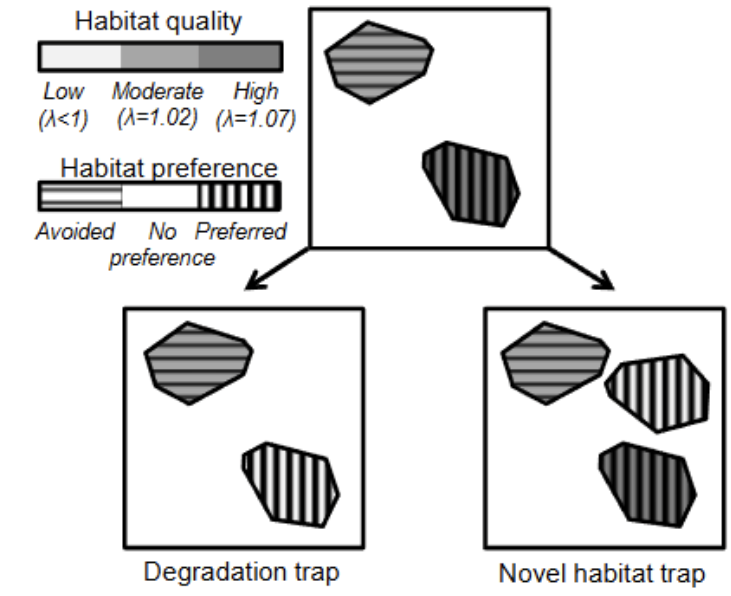
novel habitat
a habitat is introduced
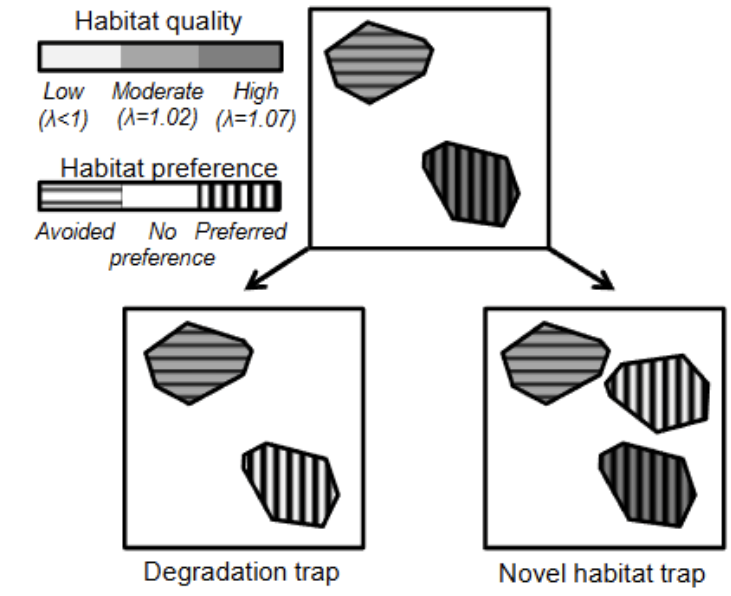
outcomes of ecological trap
persist
escape - evolve new habitat selection behaviors
extinction
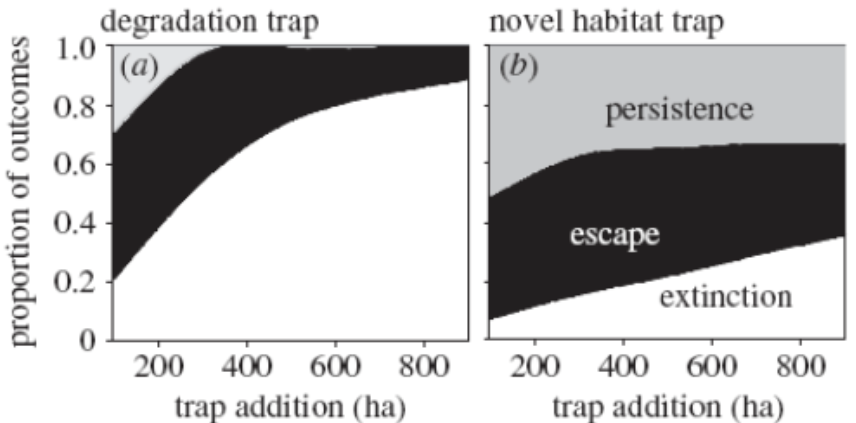
corridors
can connect/create metapopulations and increase Ne and can increase colonization rates (in plants and animals)
Tragedy of the Commons (Hardin 1968)
the exploitation of a shared finite resource where the costs are disproportionately shared across the population while the benefits are shared only by the exploiter (costs are passed off to someone else)
possible solutions of tragedy of the commons
regulate the commons, enact laws to make exploiters pay the cost of exploitation
the global commons climate game (Milinsky 2008)
people are given money and told to invest in the environment, so the group meets a climate investment threshold to not lose all their money, but their donations are not known by other players
probability of investing increases when the risk of losing increases
even at 90% only about 50% of groups met the threshold
when it was 10% almost all of the groups failed to meet the threshold
Nowak 2008
cooperation and the strategy’s payoff matricies
kin selection
r>c/b
direct reciprocity - tic-for-tat
w>c/b
indirect reciprocity - reputation
q>c/b
network reciprocity
k<b/c
k = number of neighbors per individual
group selection
1+(n/m) < b/c
n = max group size
m = number of groups
Stewart et al. 2021
impacts of invasive plants on animal behaviors (selected dependence traps)
Guilden et al. 2019
human influences on predator prey interactions
novel stages and novel actors
systematically consider role of novelties in predator-prey interaction sequence